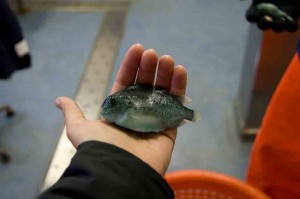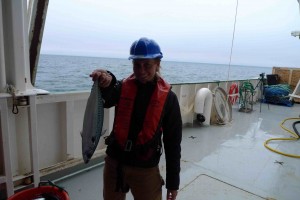ENJOY!
Tag Archives: salmon
ADDITIONS TO THE WEBSITE!!!
.
We have added images and information from our “Arctic Salmon” expedition on the Global Ocean Exploration Website…Head on over and check it all out!!!
.
http://www.globaloceanexploration.com
.
June 29: Final Day of Sampling
Â
On this final day of sampling, we found ourselves back up north…farther north than before. It seems that every day we steam north to start the sampling. The reason for this is to keep up with the migration of the salmon post-smolts. They are funneling along the shelf here off of the Voering Plateau moving with the northerly current.Â
With the anticipation of heading back to port, everyone was excited to have a great day here on the calm Norwegian Sea. With the net in the water, the sun came in and out most of the day and finally stuck around for the entire haul of the last tow. With the sun shining, the birds were soaring around the ship and the final haul came in yielding a fair number of post-smolts along with an escaped hatchery fish. This adult fish was in very good condition but had been eating seaweed because it looks like fish pellets. This is not a nutritious substitute for the small fish and plankton the fish should be eating.Â
Â
An adult salmon from the trawl.
We are now steaming back to Killybegs from above the Arctic Circle. It should be a two and half day steam. Hopefully the seas will stay calm.
The evening brought a beautiful sunset as we passed below the Arctic Circle. The sun disappeared behind a bank of fog before we could see it skim across the horizon as it would up here, but it was a stellar evening nonetheless. Â
Â
Â
Â
The Anatomy of a Trawl
Â
Trawls are commonly used to collect fish in fisheries research. They are also a very common way of fishing commercially for pelagic species (like the Russian trawlers we are seeing fishing for mackerel). The trawl being used to capture the post-smolts is not huge like those on a commercial vessel and is designed to stay on the surface. The post-smolts tend to be in the top 3 meters of the water column. Fishing right at the surface reduces our bycatch as well. The trawl is towed for anywhere from one to five hours in specific areas to target the post-smolts. Â
Â

The net coiled coming off…
Â
The net going out…the teal line is filled with floats to keep the net on the surface.
Â
Floats are attached to the mouth of the net to keep it on the surface.
Â
Large steel doors keep the net open as it is trawled.
Â
The cod end of the net coming on board.
Â
Emptying the cod end of the net…filled with post-smolts.
Â
June 26: Northernmost Point of the Cruise (or is it?)- Sampling Begins
Â
In the early morning (0330), We reached the anticipated northernmost point of the cruise, 67.5°N, the starting point for the sampling. The cruise plan was to head to this point and see what we find. If we found a large number of salmon, we would continue north. So with a CTD done and a plankton sample collected, the first trawl of the cruise was put out for one hour to test the waters. In this first haul, we found only one post-smolt so it was determined that we should turn southward to continue our sampling for the day in as Southerly direction. Our second haul was far more productive yielding 50+ salmon.Â
In addition to the post-smolt salmon, the net captured a few other species that were sampled as well: mackerel, herring and lumpsuckers. Lumpsuckers are one of my favorite fish. I don’t know much about them but they are absolutely beautiful with a crazy turquoise coloration and textured body. The mackerel are in large numbers as we see them on the surface. The population of mackerel and herring in this region is healthy and almost over-abundant due to the intense management of the stocks in the past years.Â
A small lumpsucker
A Large Mackerel
Herring (these made their way into the galley for breakfast)
Â
We are in international waters. As we headed south, we encountered the Russian trawler fleet, targeting the large mackerel shoals we are seeing on the surface of the sea. These ships are massive, well over 100 meters. One possibility for the loss of the salmon at sea is that large numbers are being discarded as bycatch.
Â
Â
Our sampling trawls stay out for about 3 hours. In that time, there is ample time to spend on the bridge looking for passing wildlife. There were some sperm whales cruising by the boat and someone sighted some orca as well. I missed the orca but saw the sperm whales. Apparently because of the ridge here, we should see quite a few whales and the sperm whales seem to like this area very much. I hope at least one of the whales wants to check out this big green boat so that I can have a closer look at him.Â
With the day of sampling completed, we will turn and head back north to begin sampling in the morning at a spot close to where we began today. The smolts are moving at approximately 15 nautical miles per day so we must anticipate this movement when choosing where to sample. Essentially, we are looking for the highest concentration of post-smolts along our journey.Â
Â













